by Lisa Cooke | May 13, 2017 | 01 What's New, FamilySearch, Research Skills |
I have thoroughly enjoyed having Amie Tennant as a blogger for the past year. In her final blog post for Genealogy Gems she takes us on a tour of her home state’s digital records. Then she will be turning all of her attentions to her own genealogical certification. Thank you Amie for all of your helpful and thoroughly enjoyable posts! – Lisa Louise Cooke
Ohio genealogy research goes digital. You can now virtually walk into any courthouse in Ohio with the click of the mouse. Check out the amazing browse-only databases at FamilySearch for Ohio and other states, and take your family history research to the next level.
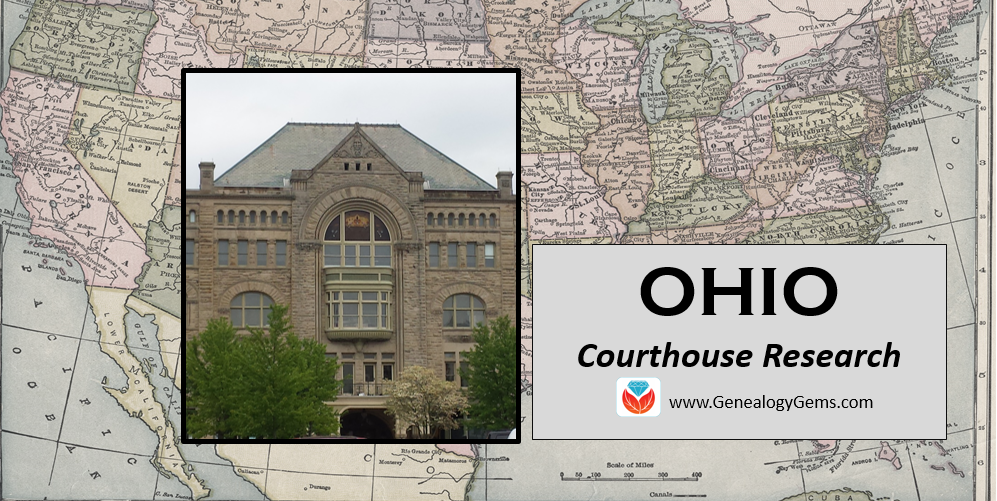
I use FamilySearch.org to search courthouse record books all the time. In particular, the Ohio Probate Records, 1789-1996 now have nearly 7 million digital images of county record books such as wills, estate files, guardianship records, naturalization records, minutes, bonds, and settlements. In fact, many other states have their court record books online at FamilySearch, too. So, why haven’t you noticed before?
Browse-only Databases vs. Indexed Databases
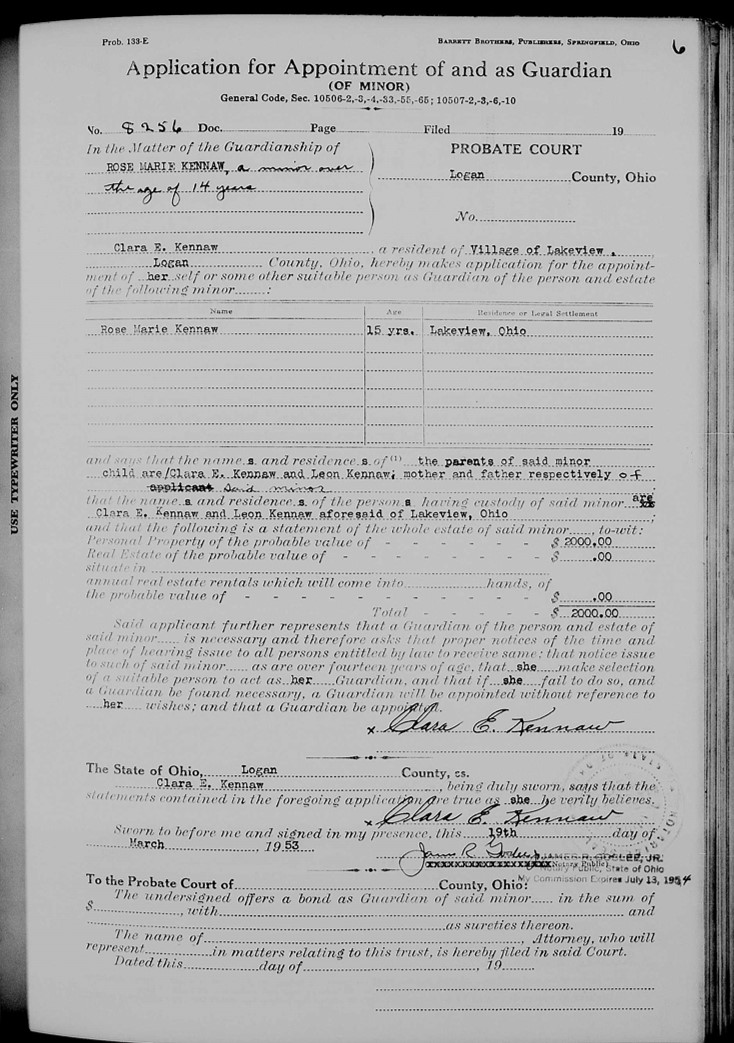 You may have read our previous post on step-by-step instructions to using browse-only databases at FamilySearch. If you didn’t, you should know that when you are searching for records at FamilySearch using the traditional search fields, you are only searching for records that have been indexed. In other words, there may be thousands of records you need on the site, but you won’t find them. They have not been indexed by a searchable name, place, or date. Instead, you need to go in the virtual “back door.”
You may have read our previous post on step-by-step instructions to using browse-only databases at FamilySearch. If you didn’t, you should know that when you are searching for records at FamilySearch using the traditional search fields, you are only searching for records that have been indexed. In other words, there may be thousands of records you need on the site, but you won’t find them. They have not been indexed by a searchable name, place, or date. Instead, you need to go in the virtual “back door.”
Step 1: First, go to FamilySearch and sign in. Next, click Search at the top right. Now you will see a map of the world. Click on the desired location. I have chosen the U.S., but you can choose any country you are interested in.
Step 2: Once you choose your desired country or continent, a pop-up list will be available and allow you to choose the state (or country) you wish to search in. In this case, a list of the U.S. states appears and I clicked on Ohio.
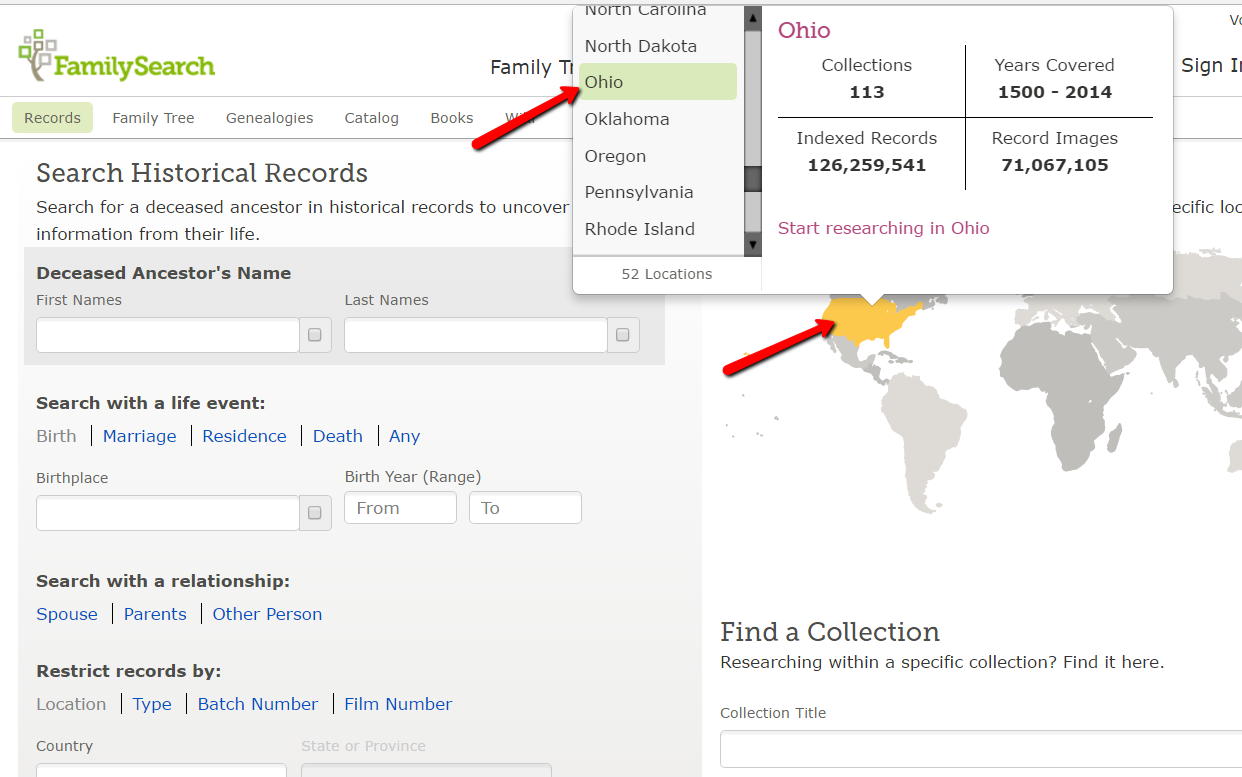
Step 3: The system will direct you to a new page. You will first see the Ohio Indexed Historical Records. These are the records and collections that have been indexed and are searchable by name, date, and place. Though these are great, they are not the record collections I want to share with you today.
Instead, scroll down until you see the heading Ohio Image Only Historical Records. You will notice several databases such as cemetery records, church records, naturalization records, etc. All of these are browseable. That means you will use them like you would microfilm.
Step 4: I want to bring your attention to a specific record collection, so scroll down even further until you see Ohio Probate Records, 1789-1996. Click it.
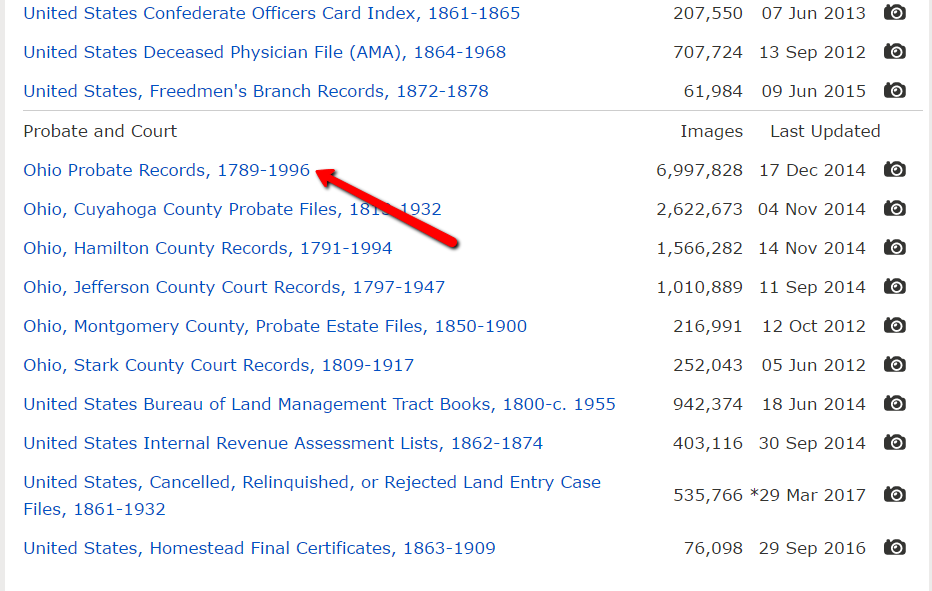
At the next screen, you will see you can browse the 6,997,828 Ohio probate records and you are probably thinking, “What!? I can’t possibly browse through nearly 7 million records!” But, you can, so go ahead and click it!
Step 5: At the new screen, you will see everything is broken up into counties. Click on the county you are interested in researching. You will next see a list of possible record books available for that county. Each county will vary, so where you may find guardianship records available in one county, you might not find them in another.
Ohio Genealogy Research at the Courthouse
As a refresher, courthouse research is often imperative to thorough genealogy research. Here is a helpful chart of the type of information you may find in these types of court records. Be sure to remember: records and the amount of information they contain change over time.
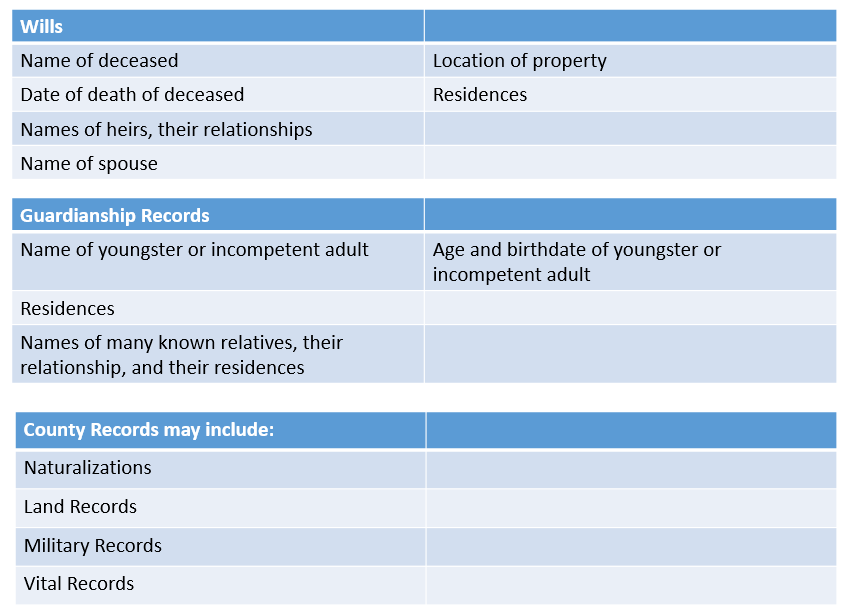
More on Courthouse Research Techniques
Are you looking to understand the value of courthouse research and how to use those records to overcome brick walls in your family tree? Read 4 Ways to Power Up Your Courthouse Research Skills from our own Sunny Morton.
by | Jul 2, 2016 | 01 What's New, Cemeteries, Listeners & Readers |
 Cemetery records are a great alternative when you can’t find a death record. Here’s how to find them!
Cemetery records are a great alternative when you can’t find a death record. Here’s how to find them!
Genealogists are always on the hunt for records about the deaths of their ancestors. Death records sometimes offer a cause of death, birth information, and parents’ names. However, when a death record cannot be found, was never created, or was lost in a disaster, where should we look next? The cemetery, of course!
Genealogy Gems reader Brenda wrote us the following message:
My father and I were visiting the cemeteries in Preble County, Ohio. We decided to take a drive down Lock Road, which is named for my ancestors. We visited the home of my two times great-grandparents, Michael and Eliza Ann Lock. While visiting with the new home owner, they mentioned the tombstone located in the fence row behind the barn. The tombstone said “Eliza wife of Michael Lock.” The tombstone is hard to read, but I was also able to make out a “13” engraved on it and I know she died August 13, 1884. My problem is that there is also a tombstone listing her with her husband who died November 21, 1928 and a separate marker that says “Mother” marking a plot in Roselawn Cemetery in Lewisburg, Ohio. Would they have moved her body when her husband died or is she still buried on the homestead? I found records at the Preble County Library that references Eliza Lock and the cemetery plot in the Roselawn Cemetery. How do I know where she is actually buried?
Just short of ground penetrating radar and exhuming the body, we may never know for sure where someone is buried. There are some things we can do, however, to get the best answer possible and maybe find some new clues in the process.
Burial Locations of the Past
According to Ohio laws in 1884, burial regulations were made on the township or village level.[1] Further, it was permissible to bury a body within 200 yards of a dwelling if the home owner gave permission.[2] [Research tip: To search the law books of a targeted area, search Google Books with a keyword phrase like Ohio laws 1884.]
It was not uncommon to bury a person on the family farm in the old days. Many people had their own family cemeteries on their property. In fact, some states still allow private burials even today. In Ohio, a person seeking to have a private burial on their property should contact the county clerk. Read more about the current Ohio burial laws here.
Possible Theories
Theory #1: Eliza was buried at the farm and a marker was placed on her grave. Her husband died in 1928 and was buried in Roselawn Cemetery. The family decided to place a marker that had both of their names on it, even though Eliza’s body was left at the farm.
Theory #2: Eliza was buried at the farm and a marker was placed on her grave. Her husband died in 1928 and was buried in Roselawn Cemetery. The family moved Eliza’s body to the same plot in Roselawn and had a stone made for both of them.
Theory #3: Eliza was buried at Roselawn Cemetery and a small stone was placed to mark the grave. Then, forty-four years later when Michael died, the family removed the original stone and replaced it with a new one which was inscribed with both of their names. What did the family do with the old marker for Eliza? They took it home to the farm as a memento.
Using Cemetery Records to Confirm A Theory
We can check the burial or cemetery records for Roselawn Cemetery to determine who is buried in the plot of Michael Lock, who purchased the plot, and maybe some more helpful hints.
Cemetery records can usually be found in a cemetery office, a library, online, or in many cases, the offices or home of the township trustees.
First, Google the cemetery name and get a phone number. When calling the cemetery office, be ready with the name of the individual and the death date if known. If a record is found, ask for a copy to be sent to you and be sure to offer to pay the cost of mailing it to you.
If you are unable to reach anyone in the cemetery office, try a quick online search. Many local county organizations are digitizing and indexing these records to put online. I searched for “Preble County Ohio genealogy,” and found a website dedicated to historical and genealogical records for Preble county.
A quick search for Eliza Lock provided a hit!

I noticed that there was a plot location and a death date, but not a burial date like I had seen on Michael’s index card. Michael’s card had two dates.

I checked many other cemetery records in this database. Several records created around the same time as Eliza’s death in 1884 also had no burial date. At first, I wondered if a record not having a burial date meant that the body wasn’t actually buried there. However, there were far too many records that did not include a burial date for this to be true.
I also noticed that this index card was a digital image and I wondered if it was created from some other source. It even seemed to have been altered with white-out. As with all genealogy research, if there is an original source, it should be found. In this case, I want to find out where these index cards came from. Were they created by someone who was looking at a ledger book? If so, then I want to see or view an image from the ledger book.
Locating the Original Cemetery Record Source
Sources come in two varieties – an original source and a derivative source. An original source is the one created at the time of the event. A derivative source is a record created later from the original, such as a transcription or abstraction. When a derivative is made, there is room for errors. This is one reason it is important to find the original source if at all possible. When it is not possible, you can use the derivative source as your proof, but you would indicate that it was a derivative and not an original.
Since this index was found at the library website, I gave them a call first. The Preble County Room assistant told me that the images were taken directly from the files held at the cemetery (the original source). The cemetery kept little index cards as their records. Volunteers later digitized those cards and uploaded them to the website (copy of an original source). According to the person I spoke to, there is no other ledger or record book that they know of. She did tell me that the image on the internet is only the top half of the digitized record (an abstract). This is yet another reason to discover how a record was made. If I had assumed this was the original record in its entirety, I would have missed some important clues.
She happily emailed me the full image of the index card (said to be a digital image of the original index card) and look what we see! [See image below]

The full record held a lot more information. When I compared the lot number of Michael and Eliza, they were the same. According to this cemetery record, it seems that Eliza’s body is buried in the same plot as her husband at the cemetery. I speculate that when Michael died, the family decided to remove the original tombstone marking Eliza’s grave, put up a new one in its stead, and take the old tombstone back home instead of discarding it.
Cemetery records are a great asset to any family history research and can often hold new information. Start today and see what you can find!
Research Tip: Did you know that in many small Ohio townships, the cemetery record books may be at the home or office of a local township trustee? The cemeteries sometimes fall under the township responsibilities, instead of county or village. In my own township, the original cemetery books were once held by the local funeral director. Now, they are held by a township trustee who is in charge of the cemeteries. You can find the names of township trustees by performing a Google search like Harrison Township Preble County Ohio township trustees.
More Gems on Cemeteries and Cemetery Records
Premium Episode 69 – Cemetery Records with Deceased Online
Merry Cemetery Displays ‘Dirty Little Secrets’ of the Dead
Reviving a Memorial Day Tradition: Paper Flowers
ARTICLE REFERENCES
[1] The Revised Laws of Ohio: Containing All the Sections of the Statutes in Annual Volumes of Ohio Laws from Seventy-seven to Eighty-one, Inclusive, Arranged on the Plan of the Revised Statutes, 1884, Google Books, (https://books.google.com/books?id=QwZIAQAAMAAJ&printsec=frontcover#v=onepage&q&f=false : accessed 20 Jun 2016,) page 87.
[2] Ibid., page 195.
by Lisa Cooke | Apr 22, 2016 | 01 What's New, Records & databases
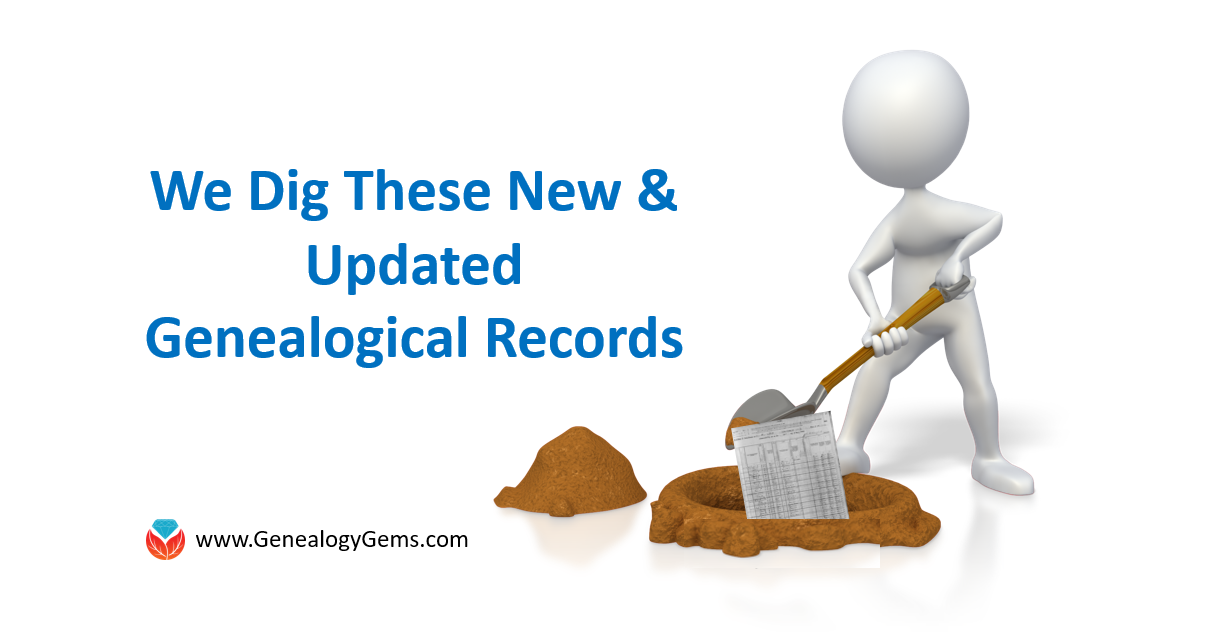 Here’s our weekly roundup of new genealogy records online. This week: Great Britain, Ireland, Sweden, the U.S. and Australia.
Here’s our weekly roundup of new genealogy records online. This week: Great Britain, Ireland, Sweden, the U.S. and Australia.
AUSTRALIA LAND. Land grant deeds for Tasmania, Australia (1804-1935) are now searchable on Ancestry.com. The format and content varies: sometimes you’ll find the name, location, description, date, payment amount and witnesses. These records come from the Tasmanian Archive and Heritage Office.
AUSTRALIA NEWSPAPERS. Over 700 newspapers digitized by the National Library of Australia (NLA) are now searchable at MyHeritage.com. This collection is also searchable at Trove, the digital newspaper library for the NLA. The benefit to having this collection at MyHeritage.com is that the site uses its Record Match technology to automatically search the newspapers for individuals on your tree, matching on several parameters to improve search results.
AUSTRALIA WWII. A new index to Australia World War II military service records (1939-1945) is available on Ancestry.com. It covers the Australian Army, Royal Australian Navy and Royal Australian Air Force. Records “commonly contain biographical information supplied on enlistment, as well as important details on a person’s service.” See info on ordering the original records from the National Archives of Australia in the Ancestry.com collection description.
GREAT BRITAIN – DIRECTORIES, ALMANACS. Ninety new volumes of directories and atlases (late 1800s and early 1900s) have been added to Findmypast’s online collection, “Great Britain, Directories & Almanacs.” According to the collection description, “Inside you will find the names of prominent people, tradesmen, people who held office, business owners and local civil servants. Discover your ancestor’s address and occupation or explore the history of your home address. The almanacs and directories stretch across three centuries.”
IRELAND – HISTORICAL. A new historical collection relating to the Easter Island uprising is available on Findmypast.com. This collection is free to search until April 27, 2016. According to a company rep, the database draws on “75,000 records that tell the story of one of the most difficult periods in 20th century Irish history. These records, once classified, include eye witness accounts, interviews with civilians and reports of the trials of the leaders of the Rising and their sentences of execution. The release also includes 25,000 search and raid records, giving detailed insights into how the Irish people of the period lived under martial law.”
SWEDEN EMIGRATION. Ancestry.com has posted a new database with over 1.3 million entries of emigrants listed in church books, 1783-1991. That represents about 75% of emigrants, of people leaving the country, during that time span. The records and index are in Swedish. This database was previously available in CD format under the name “Emibas.”
U.S. WILLS. Ancestry.com’s enormous collection of U.S. wills and probate records has been updated for the following states: Ohio, Alabama, New York, New Jersey, Arkansas and Georgia.
 Thank you for sharing this list with every genealogist you know who might be interested! We love sharing good news about new genealogy records online.
Thank you for sharing this list with every genealogist you know who might be interested! We love sharing good news about new genealogy records online.
by Lisa Cooke | Jun 5, 2015 | 01 What's New, Records & databases
Every Friday, we blog about new genealogy records online. Do the collections below include your ancestor? Don’t forget: tomorrow is Lisa Louise Cooke’s FREE live streaming class on using Google Tools to Solve Family Mysteries–use them to find more records like these! (Details below.)
This week: Irish newspapers, London electoral registers, Ohio naturalizations and Virginia vital records (through 2014!).
IRISH NEWSPAPERS. Subscribers at FindMyPast can now access over a million new Irish newspaper articles. These eight papers have updates: Cork Examiner, 1841-1896, Derry Journal, 1825-1950; Freeman’s Journal, 1820-1900; Roscommon Journal and Western Impartial Reporter, 1828-1864; Saunder’s News-Letter, 1773-1864; Ulster Gazette, 1844-1871; Waterford Chronicle, 1827-1870 and Waterford Mail, 1824-1870.
LONDON ELECTORAL RECORDS. Nearly 3 million indexed records have been added to the free England, London Electoral Registers, 1847–1913 database at FamilySearch.org. The overall collection contains more than 660,000 digital images of electoral registers filmed at the London Metropolitan Archives.
OHIO NATURALIZATIONS. Over 80,000 indexed names have been added to the US, Ohio, Southern District Naturalization Index, 1852–1991. This database covers a prime migration route: north of the Ohio River (records include courts at Cincinnati, Dayton, Columbus and Steubenville). The index points toward records that can traditionally be tough to find because people could naturalize at any court.
VIRGINIA VITAL RECORDS. Ancestry subscribers can now access these new databases: Virginia, Divorce Records, 1918-2014, Virginia, Death Records, 1912-2014, Virginia, Marriage Records, 1936-2014 and Virginia, Birth Records, 1864-2014. These records–available through 2014–come from the Virginia Department of Health.
 Here’s a tip: Harness Google’s power to search for specific record sets in which your family may appear. Watch Lisa’s free live streaming class TOMORROW, June 6, “Google Tools and Procedures for Solving Family History Mysteries.” Click here for details. Can’t watch tomorrow? You can still register to watch the class in the SCGJ archive through July 5.
Here’s a tip: Harness Google’s power to search for specific record sets in which your family may appear. Watch Lisa’s free live streaming class TOMORROW, June 6, “Google Tools and Procedures for Solving Family History Mysteries.” Click here for details. Can’t watch tomorrow? You can still register to watch the class in the SCGJ archive through July 5.
by Lisa Cooke | Mar 31, 2015 | 01 What's New, Adoption, images, United States
 Recently Genealogy Gems Premium member Katharine Ott wrote in this with newsworthy gem:
Recently Genealogy Gems Premium member Katharine Ott wrote in this with newsworthy gem:
“Recent adoption records are being released in Ohio. Such an exciting time for those adoptees yearning to connect with their bloodlines! Before the bill took effect, they allowed birth mothers to redact their names. Out of 400,000 only around 110 took them up on that. There’s also a preference form with the birth records where the mother can request not to be contacted. I wonder how often that might not be respected. It’s such an interesting situation for someone to be in.”
Wow, that’s huge news about Ohio adoption records! Thanks for the news, Katharine. She sent us this link to a local news story that covers the story. The Ohio Department of Health posted this webpage about ordering adoption records.
Want to learn more about accessing adoption records in any state? Check out the U.S. Adoption Research page at the FamilySearch wiki for a terrific overview and helpful links.
 Also, try running a Google search for the name of the state and the keywords adoption and genealogy. You’ll find lots of great resources, like this page on adoption records at the Pennsylvania state library or this online resource from the State Historical Society of Missouri.
Also, try running a Google search for the name of the state and the keywords adoption and genealogy. You’ll find lots of great resources, like this page on adoption records at the Pennsylvania state library or this online resource from the State Historical Society of Missouri.
The right Google search can shorten your search for the records you want! This tip brought to you by the newly-published, fully-revised and updated 2nd edition of The Genealogist’s Google Toolbox, Second Edition by Lisa Louise Cooke.

 You may have read our previous post on step-by-step instructions to using browse-only databases at FamilySearch. If you didn’t, you should know that when you are searching for records at FamilySearch using the traditional search fields, you are only searching for records that have been indexed. In other words, there may be thousands of records you need on the site, but you won’t find them. They have not been indexed by a searchable name, place, or date. Instead, you need to go in the virtual “back door.”
You may have read our previous post on step-by-step instructions to using browse-only databases at FamilySearch. If you didn’t, you should know that when you are searching for records at FamilySearch using the traditional search fields, you are only searching for records that have been indexed. In other words, there may be thousands of records you need on the site, but you won’t find them. They have not been indexed by a searchable name, place, or date. Instead, you need to go in the virtual “back door.”



 Cemetery records are a great alternative when you can’t find a death record. Here’s how to find them!
Cemetery records are a great alternative when you can’t find a death record. Here’s how to find them!


 Here’s our weekly roundup of new genealogy records online. This week: Great Britain, Ireland, Sweden, the U.S. and Australia.
Here’s our weekly roundup of new genealogy records online. This week: Great Britain, Ireland, Sweden, the U.S. and Australia. Thank you for sharing this list with every genealogist you know who might be interested! We love sharing good news about new genealogy records online.
Thank you for sharing this list with every genealogist you know who might be interested! We love sharing good news about new genealogy records online.
